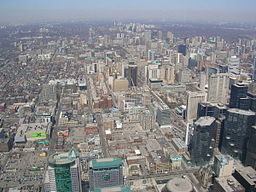Urban population

Urban population refers to the population inhabiting areas that have a greater population density than rural areas and are overall more compact than rural areas. In simple terms, it's the people living in cities.
As well as being more densely populated than rural areas, in wealthier countries there is generally a higher percentage of people living in urban centers than on rural land. Thus, the percentage of people living in urban centers compared to the rural population can be an indication of the overall development and wealth of a country. Going forward, as world population increases, organizations like the United Nations predict that the percentage of people living in urban centers will steadily increase as people migrate from rural areas into cities.[2]
Effects of Increased Urban Population
The continuing growth of urban populations has both positive and negative side effects on people's lives and the environment. Urbanization can, at times, improve both the economy and education as people move to the cities in search of higher-income jobs and better schooling. A prime example of this would be in Beijing, where many young people from rural areas move in search of jobs. As well, urban centers such as this one often contain more high-ranked schools and universities, leading to a higher level of education among citizens, and access to health care and social services is often better in cities.[3]
However, there are numerous environmental side effects of urbanization that are detrimental. Urbanization will lead to a dramatic increase in metal use, specifically with metals such as steel for construction. The increased urban population will also increase the demand for energy, with more access to electricity and other amenities, especially due to rural-urban migration. This will have a large impact on energy demand worldwide. More specific issues will also arise, such as pollution, increased cost and difficulty of providing public transportation, and destruction of wildlife habitat.[4]
For more information, please see the UN's World Population Division.
See also: Rural population
Interactive Map
The heat map below can be used to show which countries have a comparatively large portion of their population living in urban centers. A darker colour indicates a larger portion of the population living in the cities. Scroll over the map to look at the names of the countries and the percentage of their population that lives in urban centers.
For Further Reading
- World population
- Rural population
- Economy
- Gross domestic product
- Developing countries
- Access to electricity
- Or explore a random page
References
- ↑ "Toronto urban sprawl" Licensed under CC BY-SA 1.0 via Wikimedia Commons -http://commons.wikimedia.org/wiki/File:Toronto_urban_sprawl.jpg#mediaviewer/File:Toronto_urban_sprawl.jpg
- ↑ United Nations Population Division. (2015, Feb. 18). Country Profiles [Online]. Available: http://esa.un.org/unpd/wup/Country-Profiles
- ↑ Gunnar Tellness. (2015, Feb. 18). Positive and Negative Public Health Effects of Urbanisation [Online]. Available: http://eurpub.oxfordjournals.org/content/15/5/552
- ↑ Terri Mashour and Lauren McDonell. (2015, Feb. 18). Side Effects of Urban Sprawl [Online]. Available: http://www.interfacesouth.org/products/changing-roles/changing-roles-notebook/module-3/fact-sheets/mod3fs4.pdf

